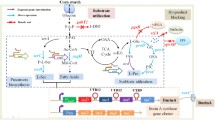Abstract
An attempt to enhance recombinant human lysozyme production by Kluyveromyces lactis K7 was performed in this study. In this study, the production of recombinant human lysozyme was investigated using shake flasks and bioreactor under different cultivation conditions. It was demonstrated that 25 °C could enhance human lysozyme production when compared with other temperatures tested. This study also demonstrated that higher biomass did not necessarily produce higher human lysozyme, and it was clear that human lysozyme production was enhanced under unfavorable conditions such as low acidity and oxygen limitation. Cultivation condition with no pH control demonstrated better production than with pH controlled near neutrality. Oxygen limitation also resulted in higher recombinant human lysozyme production. Overall human lysozyme was increased from 64.1 U/ml in flask to 123.6 U/ml in fed-batch fermentation using 4.5% (w/v) glucose initially and fed with concentrated lactose to achieve 9% lactose concentration.




Similar content being viewed by others
References
Balasubramaniam, D., Wilkinson, C., Cott, K., & Zhang, C. (2003). Tobacco protein separation by aqueous two-phase extraction. Journal of Chromatography A, 989, 119–129.
Breunig, K. D., Bolotin-Fukukara, M., Bianchi, M. M., Bourgarel, D., Falcone, C., Ferrero, I., et al. (2000). Regulation of primary carbon metabolism in Kluyveromyces lactis. Enzyme and Microbial Technology, 26, 771–780.
Dillon, V. M., & Board, R. G. (1994). Natural antimicrobial systems and food preservation. Wallingford, UK: CAB International.
Iwata, T., Tanaka, R., Suetsugu, M., Ishibashi, M., Tokunaga, H., Kikuchi, M., et al. (2004). Efficient secretion of human lysozyme from the yeast, Kluyveromyces lactis. Biotechnology Letters, 26, 1803–1808.
Jolles, P. (1996). Lysozymes: Model enzymes in biochemistry and biology. Berlin, Germany: Birkhauser.
Kiers, J., Zeeman, A., Luttik, M., Thiele, C., Castrillo, J. I., Steensma, H. Y., et al. (1998). Regulation of alcoholic fermentation in batch and chemostat cultures of Kluyveromyces lactis CBS 2359. Yeast, 14, 459–469.
Lee-Huang, S., Maiorov, V., Huang, P., Ng, A., Lee, H. C., Chang, Y. T., et al. (2005). Structural and functional modeling of human lysozyme reveals a unique nonapeptide, HL9, with anti-HIV activity. Biochemistry, 44, 4648–4655.
Lonnerdal, B. (2002). Review: Expression of human milk proteins in plants. Journal of the American College of Nutrition, 21, 218–221.
Lopez-Pedemonte, T. J., Roig-Sagues, A. X., Trujillo, A. J., Capellas, M., & Guamis, B. (2003). Inactivation of spores of Bacillus cereus in cheese by high hydrostatic pressure with the addition of nisin or lysozyme. Journal of Dairy Science, 86, 3075–3081.
Merico, A., Capitanio, D., Vigentini, I., Ranzi, B. M., & Compagno, C. (2004). How physiological and culture conditions influence heterologous protein production in Kluyveromyces lactis. Journal of Biotechnology, 109, 139–146.
Mincheva, K., Kamburiva, V., & Balutzov, V. (2002). Optimization of S-adenosyl-l-methionine production by Kluyveromyces lactis on whey in batch culture using a mathematical model. Biotechnology Letters, 24, 1773–1777.
Naidu, A. S. (2000). Natural food antimicrobial systems. Washington DC, USA: CRC.
Osserman, E. F., Canfield, R. E., & Beychok, S. B. (1974). Lysozyme. New York, USA: Academic.
Pongtharangkul, T., & Demirci, A. (2006). Effects on pH profiles on nisin production in biofilm reactor. Applied Microbiology and Biotechnology, 71(6), 804–811.
Richard, M. P., Ramesh, C. C., & Khem, M. S. (1965). A rapid and sensitive assay of muramidase. Proceedings of The Society for Experimental Biology and Medicine, 119, 384–386.
Rossolini, G. M., Riccio, M. L., Gallo, E., & Galeotti, C. L. (1992). Kluyveromyces lactis rDNA as a target for multiple integration by homologous recombination. Gene, 119, 75–81.
Swinkels, B. W., Van Ooyen, A., & Bonekamp, F. J. (1993). The yeast Kluyveromyces lactis as an efficient host for heterologous gene expression. Antonie van Leeuwenhoek, 64, 187–201.
van Ooyen, A. J. J., Dekker, D. P., Huang, M., Olsthoorn, M. M. A., Jacobs, D. I., Colussi, P. A., et al. (2006). Heterologous protein production in the yeast Kluyveromyces lactis. FEMS Yeast Research, 6, 381–392.
Webster, T. D., & Dickson, R. C. (1988). The organization and transcription of the galactose gene cluster of Kluyveromyces lactis. Nucleic Acids Research, 16, 8011–8028.
Acknowledgements
The funding for this project was provided by Pennsylvania Agricultural Experimental Station. Authors would like to have special thanks to Ms. Lisa Wilken of Texas A&M University and Dr. Mike Zhang of Virginia Tech on lysozyme analysis.
Author information
Authors and Affiliations
Corresponding author
Rights and permissions
About this article
Cite this article
Huang, E.L., Demirci, A. Enhanced Human Lysozyme Production by Kluyveromyces lactis . Food Bioprocess Technol 2, 222–228 (2009). https://doi.org/10.1007/s11947-008-0062-1
Received:
Accepted:
Published:
Issue Date:
DOI: https://doi.org/10.1007/s11947-008-0062-1




